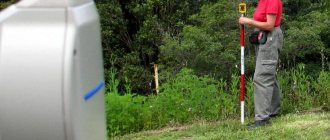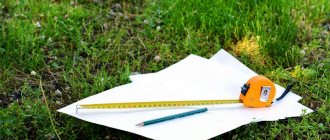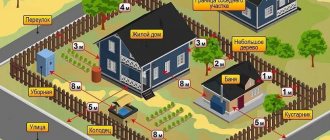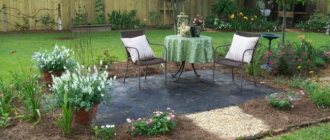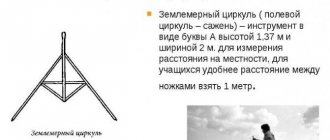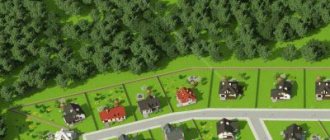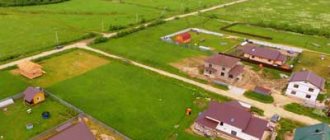Summer residents quite often wonder how many meters are in a hundred square meters. And you don’t always have an understanding of how many meters are in a hundred square meters or you don’t know how to convert hundred square meters into square meters, after reading our article you will know exactly how to do this.
The size of one hundred square meters of land is 100 m²
What is a hundred square meters of land - its values in different units of measurement. Let's calculate the sizes using examples of specific areas.
What is weaving?
Traditionally in Russia, land plots were measured in dessiatines. After the revolution of 1917, a new unit of measurement was introduced - ap. Ap is a square of 10 by 10 meters and is equal to 100 m2.
Read also: How the Edadil application works
The new value made it easier to calculate the area - a section of territory was determined by the number of squares included in it, measuring 10x10 meters. Over time, among the people, the word “ap” was replaced by the more familiar and understandable word “hundred”. If you are asked: “One hundredth is how many square meters?”, or “One hundredth of land is how much?”, feel free to answer: “1 hundredth is 1 ap or 100 square meters.” This means that the answer to the question: “10 acres is a plot of 100 by 100 meters?” will be: “10 acres is a plot of 100 by 100 meters.”
Measures
In each state, the government has established certain units of measurement for various quantities. An accurately calculated unit of measurement, adopted as a sample, is called a standard or exemplary unit. Model units of the meter, kilogram, centimeter, etc. were made, according to which units for everyday use were made. Units that have come into use and are approved by the state are called measures.
Measures are called homogeneous if they serve to measure quantities of the same kind. Thus, gram and kilogram are homogeneous measures, since they are used to measure weight.
How to find out how many acres there are on a plot
We found out how many meters in an arena, so from theory to practice. To convert this value into square meters, remember the capacity of 1 hundred square meters - this is 100 m². To visually represent the area of land in one hundred square meters, we measure it in meters and get the required number.
Suppose you measured the territory with a tape measure and found out the distance on each side: the length of the site was 65 meters and the width was 40 meters. To calculate the total area, all that remains is to multiply the resulting numbers: 65x40 = 2600 square meters.
Now we convert meters to hundreds. To do this, divide the land area in meters by the number of meters in 1 hundred parts: 2600/100 = 26 hundred parts. We carry out a similar algorithm of actions in reverse order if hundreds need to be converted to meters. Literally: 40 acres x 100 m = 4000 m².
To calculate in hectares, a similar principle is used, only meters are divided by 10,000, since 1 hectare is equal to 10 thousand square meters. The easiest way is to find out the area of the plot in the form of a rectangle or square with the correct shape.
What it is
A hundred square meters of land is a generally accepted measurement of land plots. The name comes from the word “hundred”. Because one hundred square meters is 100 square meters.
To understand the exact size of the plot, you will first need to correctly measure the length, width and calculate the area in square meters.
Knowing the footage of your estate, you can safely begin planning construction.
How to measure one hundred square meters of land in meters
The article has already mentioned what a hundred square meters of land is equal to; it is worth dwelling on this issue in more detail. Measuring one hundred square meters in meters is suitable for calculating a small plot of land, such as a summer house or a vegetable garden.
Interesting fact. The concept of a hundred square meters is accepted at the official level, and often in documentation there is a text that provides a calculation of the cost of a land plot in hundred square meters.
In order not to get confused, how to measure one hundred square meters of land in meters, you need to remember:
The area of one hundred square meters is equal to one hundred square meters; it is enough to imagine a plot of land that is 10 meters long and the same amount wide.
We measure one hundred square meters of land in meters
Ancient measures in modern language
In modern Russian, ancient units of measurement and words denoting them have been preserved mainly in the form of proverbs and sayings
sayings:
“You write in arshin letters” - large “Kolomenskaya verst” - a humorous name for a very tall person. “Oblique fathoms in the shoulders” – broad-shouldered
in poetry:
You can’t understand Russia with your mind, you can’t measure it with a common (official) yardstick. Tyutchev
Currency units
- Quarter = 25 rubles
- Ruble = 2 half
- Tselkovy – colloquial name for the metal ruble
- Poltina = 50 kopecks
- Quarter = 25 kopecks
- Five-altyn = 15 kopecks
- Altyn = 3 kopecks
- Dime = 10 kopecks
- kidney = 1 half
- 2 money = 1 kopeck
- 1/2 copper money (half a coin) = 1 kopeck.
- Grosh (copper penny) = 2 kopecks.
- Polushka (otherwise half money) was equal to one kopeck. This is the smallest unit in the ancient money account. Since 1700, half coins were minted from copper = 1/2 copper money was equal to 1 kopeck.
Foreign names:
Pint is an old French measure of liquids, about 0.9 liters; in England and the USA - a measure of the volume of liquids and bread, approximately 0.57 l Eighth of a pound = 1/8 pound Gallon English. – 4.546 l Barrel – 159 l Carat – 0.2 g, weight of wheat grain Ounce – 28.35 g Pound eng. – 0.45359 kg 1 stone = 14 pounds = 6.35 kilograms 1 small handweight = 100 pounds = 45.36 kg. Yard -91.44 cm. Nautical mile - 1852 m 1 cable - tenth of a mile Rumbus - 11 1/4° = 1/32 fraction of a circle - unit of angular measure Nautical knot (speed) = 1 mile per hour
Ancient Russian quantities:
Chet – a quarter, quarter, 'quarter of wine' = a quarter of a bucket. 'quarter of grain' = 1/4 kady kady - old Russian measure of bulk solids (usually four pounds) Osmina, osmukha - eighth (eighth) part = 1/8 The eighth part of a pound was called osmushka (“ 8 ounces of tea”). 'a quarter to eight' - time = 7:45 am or evening Five - five units of weight or length Foot - a measure of paper, formerly equal to 480 sheets; later - 1000 sheets 'one hundred and eighty osmago of November of the day of osmago' - 188 of November eighth Pregnancy - a burden, an armful, as much as you can grab with your hands. Half a third - two and a half Half five = 4.5 Half eleven = 10.5 Half a third hundred - two hundred and fifty Field - ' arena, lists' (115 steps - a variant of the value), later - the first name and synonym of 'verst' (field - million - mile), Dahl has a variant of the meaning of this word: “daily march, about 20 versts” “Printed fathom” - government (standard, with the state mark), measured, three arshins Cut - the amount of material in a single piece of cloth, sufficient for the manufacture of any clothing (for example, a shirt) “No estimate” - no number Sversnna, perfect - suitable, to match
MiscellaneousPower Strength Units Money Directory
Javascript is disabled in your browser. To perform calculations, you must enable ActiveX controls!
Source
Calculation of land along the perimeter
To correctly draw up a site plan, you need to know how many meters around the perimeter are in one hundred square meters.
There are two easiest ways to measure:
- Calculate the lengths of the sides in steps. The step of an adult is approximately 1 m. Ten steps in one direction, then the other is equal to 1 hundred square meters. This is a method by eye, suitable for a summer cottage where you need to install a utility block. When planning the construction of a house or townhouse, you need to invite a specialist who will take accurate measurements using professional equipment.
- Place pegs along the boundaries of the site at a short distance from each other and connect them with a rope. Take a tape measure and count the length of the rope on all sides.
According to the standards, one hundred square meters per family is enough to build a residential building. With a larger plot size, you can build a bathhouse, garage, gazebo.
How to use this data?
Let's say you plan to build a house with an area of 100 square meters on a plot of 8 acres. Accordingly, we divide 100 by 1 and we get that the house will occupy an area of 1 hectare. We can use the remaining 7 acres at our discretion: plant a vegetable garden, build a garage, bathhouses, greenhouses, etc.
You can draw a site plan on paper, determine where the house is located, how much space it takes up, and the location of other buildings and plantings.
Measuring the area of a plot in steps
If, when inspecting the area of interest, you do not have measuring instruments with you, or even a tape measure, you can calculate the area of the site “by eye”. As an option, there is a way to calculate the size of the plot in steps.
It is well known that the average person's step size is 0.7 m. Thus, in order to calculate one hundred square meters, you take 12-14 steps in one direction, then at a right angle take the same number of steps in the other direction. A square of 12-14 steps is one hundred square meters of land.
How to measure the area of a plot with a stick?
Another way to measure an area is to build a stick 1 meter (or two) long and take measurements with it.
The most accurate length of the stick can be determined using the height of the body or any object whose size is known. This can be a paving slab (usually 30 cm), a fence post, or can be measured by stretching your thumb and index finger (approximately 20 cm).
How to calculate one hundred square meters of land using a stick? Very simple. Measure both sides of the plot 10 times and you will get one hundred square meters.
There is also a more advanced way of using this method, when a tripod or, as it is also called, a “fathom”, is made from three sticks. From experience, we can say that measuring an area with a fathom is much faster.
Measuring an area with a tape measure
This is the most accurate and optimal way. In general, if you are selecting a plot to buy, make it a rule to always have a tape measure with you. And a calculator.
Using them and the above formulas, you can accurately calculate the size of almost any plot and check the words of the seller even before negotiations / making a deposit.
Don't forget to add the Nedvio website to your Bookmarks. We talk about construction, renovation, and country real estate in an interesting, useful and understandable way.
How many acres and meters in a hectare
If land plots are large, for example, in the agricultural sector of the economy, large system indicators are used, for example, hectares.
The relationship between non-systemic and metric indicators:
- 1 square meter is one hundredth of a hundredth;
- 1 weave - 100 squares;
- 1 cell — 0.01 hectares;
- 1 hectare is 10 hundred;
- 1 square kilometer equals 10 thousand hundred.
The land area in acres is converted to hectares by dividing the value by 100; the reverse translation involves multiplying by 100. It is necessary to change the units of measurement, since in documents the area is expressed in squares or hectares. For example, there are 3 hectares of arable land, you need to calculate the size in hundreds. To do this, 3 is multiplied by 100 to get 300 acres. If you multiply by 100 again, you get the square footage in m²: 300 x 100 = 30 thousand.
In the second example, the area of land ownership was expressed as 2.5 thousand m², but you need to get the area in hectares. Divide 2500 m² by 100, you get 25 hundred. Then the resulting value is divided again by 100, and the size of the plot is found in hectares: 25 / 100 = 0.25 hectares.
Details
Square Meter Conversion
Reference! One hectare contains a square with a side of one hundred meters. If the side size of the plot is 100 m, its area will be one hectare, otherwise 10,000 m2.
To find out the size of a land plot, expressed in hectares, you need to have a little data. To do this, you need to know the values of the length and width of the territory.
Calculation steps:
1.to calculate the area, multiply the width with the length.
2. when receiving a figure of over 10,000 m2, this means that the area value will be over 1 hectare.
3. If you need a more accurate result, expressed in hectares, the value in hectares should be divided by ten thousand.
Attention! There is an online calculator to calculate units of measurement. If there is no Internet, you will have to do the calculations yourself
Here you will need knowledge of how to correctly translate values:
If there is no Internet, you will have to do the calculations yourself. Here you will need knowledge of how to correctly translate values:
-in 1 hectare - 10,000 m2
-in 1 hundred square meters there is 1 ar, or 100 m2
-in 1 hectare there are 100 acres, or 100a
Conversion of acres
The measure of measurement originates from the number 100. One hundred square meters represents 100 m2, or 1 a.
Ares, as a unit of measurement, are not included in the SI. By multiplying the length and width of a square with a side of ten meters, you get an area of land equal to 1 are.
If a plot of land is bought or sold for a summer residence or for building a house, then the land is measured in hundreds. This term is used between people in conversations; it is not used in documents.
Convert hectares to hectares
One hectare contains one hundred acres. How to calculate area in acres. There are two methods.
1. the area in acres should be divided by one hundred to obtain the value in hectares.
2. you should multiply the area in acres by 0.01.
Example: The area of the plot is eight hectares. This means that 8 times 100 equals eight hundred acres. Or you are given a plot of land with an area of 2 thousand acres, you should divide this figure by 100, you get 20. So 20 hectares is the area of this plot.
Square kilometers, their application
One hectare has 10,000 m2. In the Russian Federation, not only these measures are used to measure area. The most common are macaws or hundreds. They are used in specific cases.
In other words, it is a square with a side equal to 1 thousand meters. And one km2 is equal to 1,000,000 square meters. This unit is used if you need to determine the area of a city, region, region, continent, or planet. For example, planet Earth has an area of 510,072 thousand km2.
Attention! 1 square kilometer is equal to one hundred hectares, otherwise one hectare is equal to only 0.01 of km2. https://www.youtube.com/embed/ylPSRtN80go
How to measure one hundred square meters of land if it is located on a slope
Not all areas are flat, so what should you do if there is a slope? For this case, there is a special device called a level.
We measure the plot on the slope in acres
To take measurements using a mechanical device, a rod is installed in the center of the earth, and the measuring device is installed in a horizontal plane. A rod is placed vertically on the boundary stone and measurements are taken, and the resulting result is recorded. The measuring rod is then moved to another boundary stone and the values are determined again. In this way, the slope of the terrain is known and, using the triangle rule, the desired value is obtained.
Why is a hectare called “non-systemic”
If you carefully read the definitions of HECTARE, you might have noticed the phrase “non-systemic unit of area measurement”. By the way, the APA has the same thing. Let's tell you what this means.
First of all, it must be said that the use of the term HECTARE began in 1879. Official permission was issued by the International Committee of Weights and Measures.
This is an organization that ensures that the same tools and quantities are used throughout the world when measuring length, weight, time, and so on. Otherwise there would be terrible confusion.
Just imagine that in France there would be meters and kilometers, and in Russia they would continue to measure distances in arshins and elbows the old fashioned way.
So this very International Committee of Weights and Measures in 1879 allowed the use of HECTARE when measuring area. At the same time, abbreviated designations for this quantity appeared - “ha” and “ha”.
But the resolution of the International Committee of Weights and Measures came into conflict with the older and more authoritative SI System of Units . It was founded a hundred years earlier (1770) and is a collection of standards for units of measurement of various parameters.
What these parameters are can be seen from the following table.
So, in the SI , no HECTARE simply could exist, since the METER and its derivatives - millimeter, centimeter, decimeter, kilometer, and so on - are responsible for the lengths (and, accordingly, for the area).
But the SI System allows the use of “foreign” units of measurement. They are called “ non-systemic ”. By the way, the hectare in this list is in very representative company. The same category includes, for example, minute, hour, day, ton, quintal and liter.
How to convert meters to hundreds
Considering that 1 hundred square meters is equal to 100 m2, we go the opposite way to convert the data from meters to hundred square meters. This will allow you to obtain correct results of measuring the area of a given land plot. When calculating the number of square meters in a hundred square meters, you need to divide the resulting result by 100, for example:
- plot area - 1000 m2;
- 1000 m2 divided by 100;
- number of acres - 10
If your plot has an irregular geometric shape, but you have correctly calculated its area in square meters, the method for calculating the size in acres remains the same. Large areas are usually measured in hectares, each consisting of 10,000 square meters or 100 acres.
Other units of measurement
Having figured out how many acres are in a hectare of land, it is easy to translate indicators from ancient Russian measurement systems. The same applies to reverse translation of values.
Tithe
It is useful for people studying history and historical documents to know that a tithe of land is how much in acres. This unit of measurement was used when calculating the area of land. It was actively used before the introduction of the metric system. At the same time, there were several varieties of this value, for example, the government tithe was equal to 2400 fathoms squared.
For a visual representation, tithes mentally draw a territory with a length of 80 fathoms and a width of 30 fathoms. There may be another option - 40 fathoms wide and 60 fathoms long. A similar unit of measurement has been used since the 14th century. At first, two quarters were used to determine it. If you need to imagine a tithe in the form of a square, then each side is equal to 2500 fathoms squared or 1/10 of a verst.
In Ancient Rus' there were several types of tithes:
- A hundredth tithe is equal to 10,000 fathoms squared. It can be imagined as a square plot with sides of 100 fathoms.
- Economic tithe was also called scythe. Essentially, this is a plot of 40x80 fathoms or 3.2 thousand squares.
- Another type of economic tithe is round. This is a square territory with a side of 60 fathoms or 3.6 thousand squares.
- A plot measuring 10x80 is also called a melon tithe. If you measure the area in square fathoms, then it is 80 squares.
Acre
Now it’s the turn to consider an acre of land - how many hundred square meters? This land measure is used in countries with the English measurement system, for example, in the USA, Great Britain, Australia and Canada.
When converting acres, use the following rules, 1 acre is equal to:
- 0.004 square kilometers or 1/250 km²;
- 4 ore;
- 4840 yards square;
- 0.405 ha;
- 0.00405 acres;
- 0.37 dessiatines;
- 888.97 fathoms square;
- 40.46856 are;
- 1/640 miles squared;
- 1/30 of the land yards.
Previously, an acre referred to the area of land that one farmer cultivated in a day. In our country this unit of measurement is not used.
Application of information about weaving
Knowing how much a hundredth is and how to convert it to other units, you can use this knowledge in everyday life. For example, when planning the construction of a house measuring 8 x 10 meters on a plot of 6 acres. In this case, it is easier to convert the area of the building in plan into these units of measurement. This will be 0.8 acres, and 5.2 acres of the dacha area will remain free, on which you can place a garage, greenhouse or bathhouse, plant a vegetable garden or arrange a garden. Their areas can also be indicated in the same units. And, although the term “weave” is usually not used for premises, it is quite suitable for calculating the territory of a dacha. The calculation rules apply in both directions. And, if the ad states that a plot of 9 acres is for sale, buyers can imagine a square measuring 30 x 30 meters and plan the placement of other buildings and landscape design elements. On the other hand, plots are rarely square. And an area of 9 acres can mean an area measuring 20 x 45 meters, or 25 x 36 m, or even 22 x 41 m - the error in determining the area can reach several square meters.
The most difficult thing to deal with is areas of non-standard shape - triangular, trapezoidal, polygonal. And, although usually when setting the size of plots they try to make them at least rectangular, the terrain can adjust the results. To solve the problem, it is worth remembering the calculation formulas from school mathematics. It is preferable to break complex figures into several simple ones. Areas in acres or square meters are easily calculated for rectangular and other trapezoids or triangles.
The history of the concept of “1 hundred square meters”
In pre-revolutionary Russia, the concept of tithes was used to measure plots of land. After 1917 they were replaced by macaws. Thus, an ar is a square of 10x10 m with a total area of 100 m2.
The introduction of this value simplified the process of calculating the area of the site. The size of the plot was determined by the number of 10x10 m squares of which it consisted . Soon the archaic ar was supplanted by the easily usable sotka. Now it has become much easier to understand how many square meters in one hundred meters of land based on the definition itself: one hundred meters is one hundred meters.
There is another version of how the concept of weaving arose. Some believe that the term means a hundredth of a hectare: 1 hectare = 10,000 square meters. m / 100. In any case, hundred parts are still used today and are important in some aspects of land ownership.
Everyone knows the concept of 6 acres for agriculture. However, 6 acres is how many meters for a farm? In fact, this is 600 m2, which was allocated to a family of four during the period known in the history of the country as the planning period (1960-1970). This amount of land should have been enough to grow vegetables and fruits from 5 acres, and on the 6th acres it was planned to build a country house and outbuildings, no more than 2. This value is considered average in value today.
The concept of one hundred square meters has become so ingrained to denote the area of a plot, and it has become not only common among the people, but also enshrined in papers . For example, you can see an advertisement for the sale of a plot indicating 6 acres, not square meters.
Why do you need to know the size of land plots?
Having switched to a sedentary lifestyle, people began to measure their plots. To eliminate misunderstandings associated with subjective units of measurement, in 1791. in France, the National Assembly adopted uniform values displayed in the system of measures.
In what cases is it important to know the size of your plot in acres? Let's list some cases:
- when you are selling or buying a home;
- for landscape design;
- when dividing a plot;
- in case of land lease;
- during construction;
- in the process of territory planning;
- in agriculture.
The process of measuring land is called “surveying” and is performed by specialists with appropriate experience and tools.
Understanding the scale of your territory allows you to determine how to properly place buildings and structures on the site. At the same time, it is important to comply with the rules of SNiP, which stipulate standards for distances between buildings for fire safety purposes. Understanding how many meters are in 1 acre will allow you to competently plan and place buildings on the site.
For example, you have a plot of 6 classic acres. You are planning to build a house 8x10 m. Convert the area of the building into acres - it will be 0.8 acres. This leaves you with 5.2 acres, which you can use to build a garage, for example, a bathhouse or a greenhouse. Or you can plant a vegetable garden, the area of which is also measured in acres. Understanding how much 1 hectare is, you can calculate what and where should be placed on your land.
Now we are sure that the question “One hundred square meters of land is how many square meters?” will not take you by surprise and you will be able to make the necessary calculations.
Who should measure the plot before registration and privatization?
Measuring the area of land is called "surveying". This action is performed by specially trained people - surveying engineers.
When surveying is required:
- When purchasing a plot of land with uncertain boundaries;
- When combining areas located nearby;
- When dividing one large fence into several small ones;
- During a conflict with neighbors over the illegal seizure of part of someone else's land.
But in some cases you can do without land surveying:
- If, when purchasing land, you received a cadastral passport for this property, then you do not need to update this document
- When the owner of a plot is going to register a building located on it, it is enough to have a cadastral passport with a plot plan on a scale of 1 to 500.
